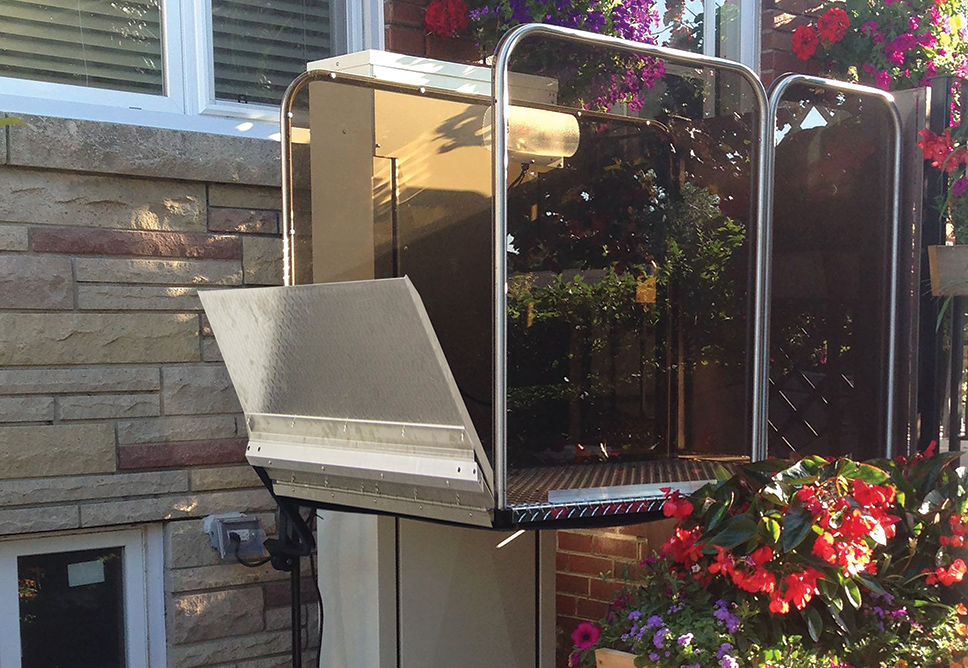When you’re confined to a wheelchair, your home mobility is definitely challenged. A stairlift can grant you access to multiple levels of your home, but when you get to the top – or bottom – of the stairs, then what? Without your chair, it’s difficult to go any further. A home elevator could solve the problem, but may be prohibitively expensive. Or your home may not allow for the infrastructure modifications a residential elevator would require.
A wheelchair lift may be just the solution for your mobility needs. Less costly than an elevator, it provides many of the same advantages, without the need for extensive residential construction. Modern wheelchair lifts are compliant with the Americans with Disability Act (ADA), and can safely and comfortably enable you to access exterior entrances to your home, or multiple levels inside your residence.
Multiple styles to fit your needs
 Whether for interior or exterior use, wheelchair lifts come in two major categories: Inclined Platform Lifts (IPL) or Vertical Platform Lifts (VPL). As the names imply, the IPL category mimics the function of chairlifts, gliding your wheelchair up a flight of stairs, while VPL models lift your chair straight up or down, similar to an elevator.
Whether for interior or exterior use, wheelchair lifts come in two major categories: Inclined Platform Lifts (IPL) or Vertical Platform Lifts (VPL). As the names imply, the IPL category mimics the function of chairlifts, gliding your wheelchair up a flight of stairs, while VPL models lift your chair straight up or down, similar to an elevator.
Both styles offer safety features to keep you and your chair stable on the lift platform, and convenience features such as easy to use onboard controls, an emergency stop function and call/send stations for each floor. Wheelchair lifts offer a quiet ride from regular 110 volt household current and feature battery back up to make sure you can get where you’re going even in case of a power outage.
IPLs are typically installed within the footprint of existing staircases, and feature platforms that fold away when not in use, allowing access to the staircase for all users. When you need to mount the stairs, simply lower the platform – either manually or with the supplied remote control – roll on and use the controls to secure the platform safety flaps and guard rails. Then the platform can be raised or lowered to the level you want to access. Different models are designed to transport riders over different distances, and some accommodate curved staircases.
VPLs typically sit adjacent to or near the stairs in your residence. These lifts can either be open platforms with just safety rails, or can feature glass walls. Some offer a full cabin design, much like a residential elevator, but with a smaller footprint. VPLs come with an enclosed drive system, eliminating the need for a machine room, making them more versatile for residential installations.
Access the outside
 Not just for your home’s interior, wheelchair lifts can eliminate a need for a large unsightly ramp leading to your door. Whether you glide over your steps or get lifted directly to the entrance level of you home, a wheelchair lift reduces the wear and tear on your wheelchair’s electric motor or the need for someone to push you up a ramp. With a lift, there are no worries about slipping backwards, or trying to navigate a ramp while balancing packages in your lap.
Not just for your home’s interior, wheelchair lifts can eliminate a need for a large unsightly ramp leading to your door. Whether you glide over your steps or get lifted directly to the entrance level of you home, a wheelchair lift reduces the wear and tear on your wheelchair’s electric motor or the need for someone to push you up a ramp. With a lift, there are no worries about slipping backwards, or trying to navigate a ramp while balancing packages in your lap.
What’s more, exterior wheelchair lifts are designed to withstand the elements and some models are even designed to work in harsh, wet climates. Choose a vertical platform lift with an optional roof, and you can reach your entrance not only safely, but dry as well!
Match your décor
Wheelchair lifts become an integral part of your home. With that in mind, manufacturers offer optional colors, finishes and features for your lift, helping you to incorporate them into you decorating style.
Whether it’s choosing the size of the fold up platform on your IPL, or the color of the tower or platform on your VPL, you can select features to make your mobility solution fit comfortably in your home, enabling you to fully access and enjoy it for years to come.
